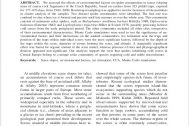Year
2005Authors
Leoš KlimešRNDr. Vlastimil Růžička, CSc.
Species
Comaroma simoni Bertkau, 1889 ENClubiona alpicola Kulczyński, 1882 ES
Diplocentria bidentata (Emerton, 1882) VU
Improphantes improbulus (Simon, 1929) VU
Kratochviliella bicapitata Miller, 1938 VU
Lepthyphantes notabilis Kulczyński, 1887 ES
Tenuiphantes zimmermanni (Bertkau, 1890) VU
Acantholycosa norvegica sudetica (L. Koch, 1875) VU
Content
We assessed the effects of environmental factors on spider communities in screes (sloping mass of coarse rock fragments) of the Czech Republic, based on catches from 325 pitfall traps, exposed for 177–670 days, from 1984–2000. Bootstrap resampling was applied to test for fuzziness of the partitions in cluster analysis of the samples. Two distinct spider communities were identified. The first one was confined to sites where ice is formed and persists until late summer or over the whole year. This community consists of numerous relict spiders, such as Bathyphantes simillimus buchari Růžička 1988, Diplocentria bidentata (Emerton 1882) and Lepthyphantes tripartitus Miller &
Svatoň 1978, possibly persisting in these cold screes from the early postglacial period. The other community included all other sites, irrespective of their environmental characteristics. Monte Carlo simulations were used to test the significance of environmental factors and their interactions on the studied communities. Ice formation near the traps and position of the traps within individual screes were the most significant factors, followed by the depth of the traps within the scree, diameter of stones forming the scree, and altitude. A marginally significant effect was found for organic content in the scree matter, whereas presence of trees and phytogeographical districts appeared non-significant. Our analyses support the view that spiders inhabiting cold screes in Central Europe belong to a unique relict community of species requiring cold and stable microclimate.
Svatoň 1978, possibly persisting in these cold screes from the early postglacial period. The other community included all other sites, irrespective of their environmental characteristics. Monte Carlo simulations were used to test the significance of environmental factors and their interactions on the studied communities. Ice formation near the traps and position of the traps within individual screes were the most significant factors, followed by the depth of the traps within the scree, diameter of stones forming the scree, and altitude. A marginally significant effect was found for organic content in the scree matter, whereas presence of trees and phytogeographical districts appeared non-significant. Our analyses support the view that spiders inhabiting cold screes in Central Europe belong to a unique relict community of species requiring cold and stable microclimate.



